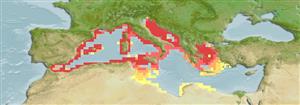Common names from other countries
Environment: milieu / climate zone / depth range / distribution range
Écologie
; profondeur 7 - 50 m (Ref. 125858). Subtropical; ? - 26°C (Ref. 125859)
Distribution
Pays | Zones FAO | Écosystèmes | Occurrences | Introductions
Endemic to the Mediterranean.
Length at first maturity / Taille / Poids / Âge
Maturity: Lm ? range ? - ? cm
Maximum depth from Ref. 125859. Found in infra- and circalittoral zones as well as bathyal zones (Ref. 85338).
Life cycle and mating behavior
Maturité | Reproduction | Frai | Œufs | Fécondité | Larves
Members of the class Anthozoa are either gonochoric or hermaphroditic. Mature gametes are shed into the coelenteron and spawned through the mouth. Life cycle: The zygote develops into a planktonic planula larva. Metamorphosis begins with early morphogenesis of tentacles, septa and pharynx before larval settlement on the aboral end.
Vafidis, D. 2010. (Ref. 85338)
Statut dans la liste rouge de l'IUCN (Ref. 130435)
statut CITES (Ref. 108899)
Not Evaluated
Not Evaluated
Menace pour l'homme
Harmless
Utilisations par l'homme
| FishSource |
Outils
Plus d'informations
Taille/Âge
Croissance
Longueur-poids
Longueur-longueur
Morphologie
Larves
Abondance
Sources Internet
Estimates based on models
Preferred temperature
(Ref.
115969): 13.6 - 16.4, mean 14.3 (based on 53 cells).
